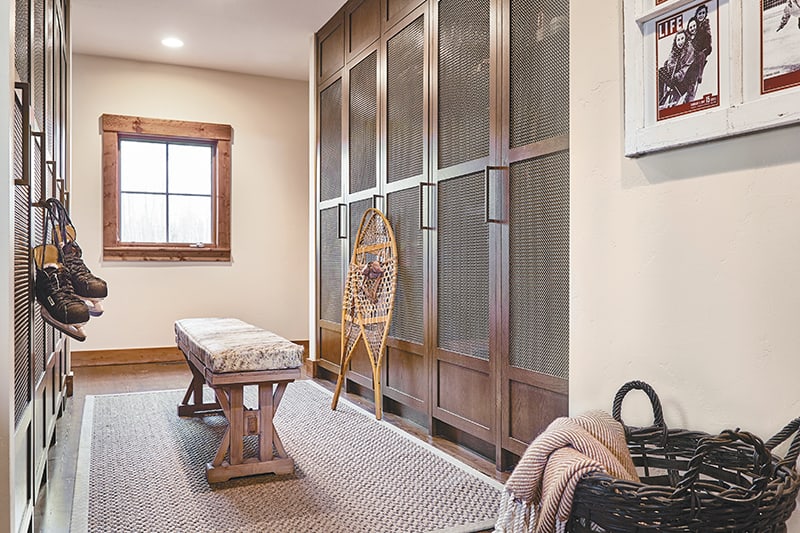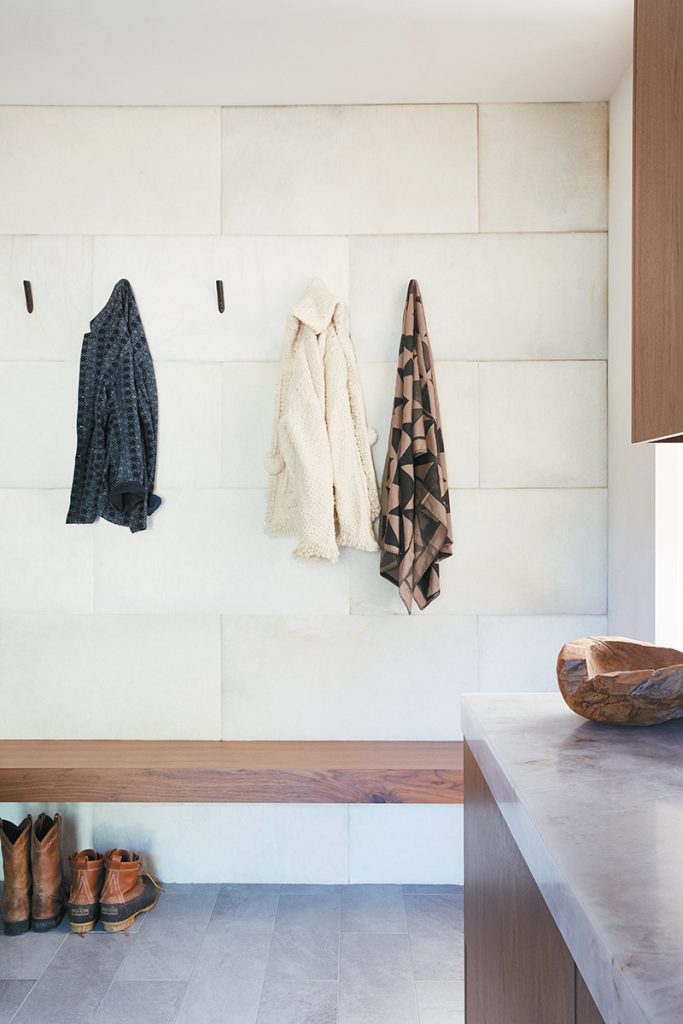Read The
Current Issue
Stuck in the Mud(room)
In Jackson Hole, a mudroom might be the most intimate, and practical, space in the house.
By Samantha Simma

This mudroom designed by WRJ caters to active homeowners. Lockers are made of dark-stained oak and metal mesh. The latter allows damp clothing to dry. Photo by WRJ Design
JACKSON HOLE HAS five distinct seasons (or maybe six): We’ve got the same four seasons as most everywhere else, and then we get mud season, which lives up to its name and comes twice a year, once between winter and spring and again between fall and winter. And, regardless of the season, year-round there is the need for local homeowners to have easy access to boots, gear, jackets, hats, and other assorted outerwear.
“Mudrooms are an important priority for everyone [in Jackson],” says Rush Jenkins, CEO and co-founder of Jackson-based WRJ Interior Design. “They are often the most used area in a home.” As such, Jenkins adds, “mudrooms here must be functional, and should still be a really nice experience aesthetically, too.”
Because of their importance and high usage, architect Tom Ward, of Ward + Blake Architects, says mudrooms in Jackson Hole homes are “oftentimes more reflective of the lifestyle of a client than any other space in a residence.” But this isn’t necessarily something you would know if you haven’t lived here through a mud season or two. Ward says newcomers to the area generally underestimate the size and importance of a mudroom. “They have not yet sampled the variety of recreational opportunities offered by the valley, and have not experienced the equipment demand made by them,” he says. And maybe they don’t yet understand that there’s a chance you’ll want your Gore-Tex or puffy jacket during any month of the year.
In their early days, mudrooms were more about function than form. They were hidden behind closed doors, shielding the rest of the home from incoming dirt and dust and from the chaos of piles of coats, boots, shoes, and gear (and wet dogs). But as home design has transitioned to include more open spaces and distinct formal entryways, and as our culture has fallen under the thrall of organization and tidying—the surname of the author of The New York Times Bestseller “The Life-Changing Magic of Tidying Up,” Marie Kondo, has become a verb and Kondo herself has an hour-long show on Netflix—mudrooms have had to up their game. You must “impose some order over the chaos,” Ward says.
Before you get to that though, you need to think of what purpose(s) you want your mudroom to serve. Consider weather, pets, children, and the type of gear you want to have handy. When Jenkins works with a client, he creates “an inventory of everything they have and what they’re going to use,” he says. “Most mudrooms are not going to contain every single thing that they have as gear. A lot of that is going to go in the garage, so the garage becomes an extension of the mudroom.” Ward says informed Jackson Hole clients look to their mudrooms to serve multiple functions, calling these mudroom 2.0s “hybrid spaces.” They could be a combined laundry room/mudroom or pantry/mudroom and/or include pet feeding and washing stations, a dog kennel, radiant floor heating, a floor drain, built-in gear dryer, and charging ports for electronics. A mudroom can even be a communication hub: Jenkins has installed chalkboards so parents and kids can leave messages for one another.
Once you know what you want your mudroom to be, it’s time to get into the specifics of how it will be organized and what it will look like. Ward and Jenkins are quick to point out that there is no “correct” way to do the former or the latter. “Some families have a place for everything and everything-in-its-place mentality for the stowage of stuff,” Ward says, while “others are much more casual—a place for a pile is good enough.” As far as a mudroom’s appearance goes, Jenkins says it should be a continuation of the home’s aesthetic, incorporating similar flooring and cabinet and countertop materials. The correct look for, and the way to organize, a mudroom is what works for your family and your home’s style.
In a Snake River Sporting Club residence named the 2018 “Home of the Year” by Mountain Living magazine, WRJ covered a mudroom wall in cowhide panels. Installed on the wall were coat hooks and a floating bench made from walnut. “That experience is wonderful for that client because it’s a beautiful aesthetic,” Jenkins says. Also, from a practical side, “cowhides are highly resilient to dirt and everything else in between.” This mudroom features other materials as beautiful as they are durable. Countertops are quartzite, doors are walnut, and the floor is stone. “Quartzite is one of my favorite materials,” Jenkins says. “Quartz is another great material to use on countertops in mudrooms and in laundry rooms because it’s super durable, harder than granite, and [sells at] a really good price point.” (While their names sound similar, quartzite and quartz are different. Quartzite is a natural stone often mistaken for marble or granite that requires periodic sealing to prevent staining. Quartz is an “engineered stone” made of ground-up stone particles bound together by plastic resins. It requires almost no maintenance and can be made to look like almost any stone.)
Kristen Carter and Diana Scholtens are designers at Bison Custom Cabinetry, a local firm that has been designing and making cabinetry for mudrooms (and kitchens, garages, libraries, closets, bathrooms, and pretty much every other space in a house) for more than a decade. They know to consider the variable needs of homeowners and the look of the home their cabinets will go in. In a South Park home, Bison designed and fabricated shelves for the mudroom that allow the homeowners to showcase their extensive selection of western hats. Sometimes the shelving and cabinetry themselves are the showpiece: Carter says she’s done cabinets in almost any color and from a variety of different woods.
Traditionally, cabinetry (doors) in Jackson Hole homes has been made from knotty alder, cherry or rustic cherry, walnut, hickory, maple, or white oak. But Carter has also done shelving and cabinet doors from bamboo, birdseye maple, lyptus, zebrawood, English sycamore, and vertical grain fir.
“[We have] the ability to obtain virtually any wood unless it is a protected species,” Carter says. “Once you’ve chosen the wood species for your project, then the stain and finish elements can be selected. Beyond a wide variety of standard paint and stain colors, a custom match would enable a client to create cabinetry to match Grandma’s hutch or coordinate with a specific color in their upholstery. Finish elements include distressing and wearing techniques, as well as highlights and glazes, to create an aged look; dry brush painting techniques, which add color and texture to a painted finish; or wire brushing, which creates a rough, weathered surface.”
The type of cabinetry found in mudrooms is often more diverse, in function and arrangement, than in other areas of a home. It’s not unusual for a mudroom to have closed closets and cabinets, open shelving, lockers, cubbies, and several benches or other seating options. One WRJ mudroom features dark stained oak lockers with fronts of metal mesh screen. The mesh screen keeps contents mostly hidden while allowing any items that are hung up damp a chance to dry.
“A mudroom is the transition space between the chaotic world and your serene living space,” Carter says. “It should serve as a place to corral the clutter, store life’s gear, and promote organization for tomorrow’s activities. Whether it provides easy-to-access hooks and cubbies or storage space hidden behind closed doors and drawers, the mudroom design should focus on function, but of course also work in concert to create the look and feel you’re dreaming of for the home.” JH

Brought alive by a striking red finish that matches elements elsewhere in the house, this mudroom is multi-purpose: it has a convenient spot to corral keys and wallets, easy-to-access storage, and deep bench drawers. The taller cabinets are for storing larger and/or out-of-season items. Photo by Krafty Photos

This WRJ-designed mudroom is chic and functional: the pattern of the bleached white cowhide panels on the wall mirrors the sleek, porcelain tile floor; the Cristallo quartzite countertop is quick and easy to clean. See this and additional images of this home in WRJ Design’s book Natural Elegance published by Vendome. Photo by William Abranowicz




